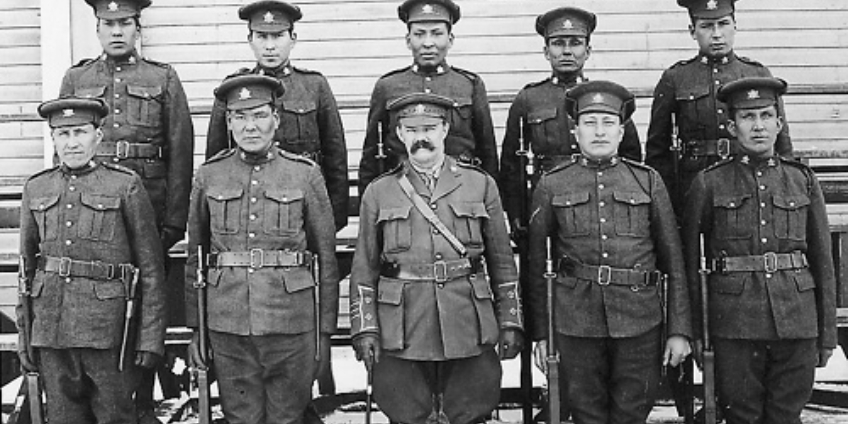For many of the more than 7,000 Indigenous people in Canada who served in the First World War, Second World War and Korean War, enlisting in the military was a chance to escape colonial constraints and reclaim their warrior heritage, according to two University of Alberta researchers.
"Each Indigenous group has their own unique stories of the war and unique interactions with local officials. And individuals had their own unique reasons for signing up," said post-doctoral researcher Will Pratt, who studies how the First World War affected the 29 men from the Treaty 7 region in southern Alberta who served in the conflict. "I'm trying to disentangle them from the national narrative."
According to Pratt, the Department of Indian Affairs and militia were uncertain about whether they were actively going to recruit Indigenous soldiers for the Great War-at first, the official policy was that they would not.
Some individuals-like Albert Mountain Horse of the Kainai (Blood) First Nation, who is regarded as one of the earliest First Nations people to enlist-managed to sign up and head overseas despite government discouragement. Albert died of his wounds in 1915.
There were several motivations for First Nations peoples from Treaty 6, 7 and 8 lands to enlist in war, often tied to existing ideas of warrior culture. For graduates of restrictive residential schools, enlisting in the First World War was an opportunity to escape the doldrums of reserve life and embark on travel and adventure, Pratt said.
"It's a complex situation," he explained. "In one sense you might think that this was part of internalizing Eurocentric values, and that they were signing up out of British patriotism or allegiance to the British Empire. But in some of the memoir literature from Indigenous soldiers, you can see that there are Indigenous notions of being a warrior and Indigenous ideals."
James Dempsey, associate professor in the Faculty of Native Studies, said going to war was one way of gaining status in their community as warriors.
"Once moved onto reserves, most avenues for males to gain status were eliminated. Intertribal warfare was not allowed, horse raiding was a crime, so they didn't have these outlets," Dempsey said.
"Then the war comes along. They didn't necessarily know what they were getting into, but they get to go to war."
Dempsey agrees that interviews with veterans provide evidence to suggest some men enlisted to "escape the boredom of reserve life." A third motivation, he thinks, is loyalty to the British Empire.
"For Indigenous people in [what is now called Alberta], there was a relationship with the Crown through the treaties, and while it wasn't always the best, I think that was one of the reasons for many of these people to enlist."
Avenging loss, honouring warriors
Mike Mountain Horse, who served in the First World War and then became a police officer, did many speaking engagements across Canada. Records show he told audiences he fought in the war as a means of revenge against Germany for killing his brother Albert during the same war.
"These revenge cycles that happened around warfare are much like what happened generations before," Pratt noted. "Mountain Horse spoke of Indigenous ceremonial prayer and small sacrifices made to the creator by his fellow soldiers during the conflict. There are accounts of incorporating Indigenous regalia-soldiers in military uniform with elk tooth necklaces. There's value in military exploits that is in keeping with the warrior values you see in Plains Indigenous cultures."
Traditional and Euro-Canadian concepts were often amalgamated during the wars, and Indigenous soldiers often deployed Indigenous ideas alongside notions of British military imperialism in their understanding of the war. Mountain Horse had a traditional story robe created to record the stories of his military service. In pre-colonial days, a story robe was a way to demonstrate feats of bravery and risk.
"War robes were worn to display achievements," Dempsey said. "Here was a way to proclaim your warrior status to others visually. The robes would be worn for special occasions to show off your status within your community. A lot of it is about status. Even to this day, during the grand opening or parade at the beginning of powwows, they always invite, and try to have, a veteran to carry one of the flags. There's that community view of veterans being warriors."
Mountain Horse's robe had visuals of him overtaking machine guns and depictions of modern artillery, with illustrations of spiked helmets to indicate the German soldiers.
Remembering Indigenous veterans
The federal government established National Aboriginal Veterans Day on Nov. 8, 1994 to honour the thousands of First Nations, Inuit and Métis people who served in the world wars, the Korean War and later conflicts.
The day is often marked by remembrance of Indigenous soldiers killed in the wars, but also acknowledges that veterans' benefits and rights were unevenly distributed to the survivors.
In 1995, the first wreaths to honour Indigenous veterans were laid at the National War Memorial.
"As a kid going to Remembrance Day celebrations, there would only be two or three wreaths," Dempsey recalled. "But now there is recognition of different groups, including Aboriginals, and the military has been recognizing that too."
